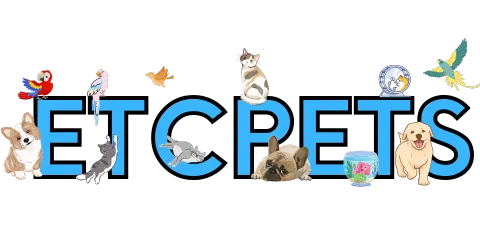If you have recently gained a new Corgi puppy in your family, you may have noticed by now that they aren’t always the furry little angels you have seen them portrayed as in pictures and videos. They are adorable, but not always the most well behaved – unless you train them to be. Disciplining your Corgi puppy can be done in a number of different ways, and for several reasons. I’ll cover some of the more common reasons and methods here.
So your Corgi did something wrong, and you want to know the proper way to discipline them for it, as well as how to break them from repeating that behavior again. Having a hard-headed Corgi myself for the past six years, I can advise of what worked and didn’t – for me. Comparing experiences with Shawna (my fellow co-writer for Etcpets.com, who is also a professional dog trainer), we came up with the following suggestions to help you throughout your Corgi’s training.
First off, let’s take a look at the definition of discipline, as it seems to have a variety of meanings to different people.
Discipline – /ˈdisəplən/ noun –
The practice of training to obey rules or a code of behavior, using punishment to correct disobedience.
The primary reason I wanted to go over the definition was that as people interpret it in different ways, their “methods” will vary as well. Sometimes, a dog will need to be disciplined, but a lot of the time, the message may not get across with the intent you had in mind. In those cases, it would behoove you and your dog much more to focus on the training rather than the punishment.
In this article, I will go over some of those circumstances where your message may be misconstrued, as well as give some suggestions for you to try out with your Corgi. One thing to remember when training any dog, Corgis included, is that there is no one-size-fits-all remedy. Like people, dogs have different personalities, which will affect their willingness to learn, but also what works and what does not as far as punishment goes.
First, let’s start with Corgis’ typical traits, as they will differ from that of some other breeds. The differences in characteristics can definitely alter your approach to training and discipline.
Table of Contents
Corgi Tendencies

Corgis are very smart, attentive, intuitive, and independent. They are energetic and packed with plenty of personality, and are often not afraid to show it. They were initially bred to assist with herding cattle, and even though they are primarily family pets today, they still exhibit a good amount of that cattle-herding instinct. Because of this, they are relatively strong-willed and not always keen on doing what they are told if it differs from what they had in mind to do.
However, if you establish a good bond with your Corgi, they do tend to become quite apt in wanting to please you. They have a lot of energy and like to play, but you can get them to the point of tiring rather quickly. From my experience, they seem exceptional at paying attention and reading your mood. That makes them much easier to train in my opinion, if you teach them properly.
One thing to keep in mind with training, or disciplining Corgis, is that they are a long-backed breed. You don’t want to do anything or put them in a situation where they could possibly get a spinal injury. While they are not typically considered to be a weak breed, it is worth mentioning and good for you to keep in mind throughout training, especially as they get older.
Discipline a Puppy for Biting While Playing
Puppies spend a lot of their time between naps curiously exploring the world around them. Whether exploring new things or playing, they often do so with their mouths. Puppies have 28 teeth that feel like sharp little needles if they decide to play-bite you. While mouthing things is perfectly normal for a puppy to do, you will want to teach your dog bite inhibition to make sure they understand not to go overboard and bite down too hard. Or teach your puppy not to bite you at all. Every dog should learn to control how much force they put into their bites, regardless of which methodology you decide to teach them when it comes to using their mouths. The biting may be cute when they are puppies, but it won’t be when they get older and can bite much harder.
Now let’s look at some ways that we can put a stop to these behaviors.
Start by saying “no!” or “ouch!” loudly and pulling away your arm, hand, or whatever your puppy decided to latch down on. Pull it back far enough that it is out of their reach. It is not necessary to scream, but it should be loud and prominent enough to grab the pup’s attention. If you repeat this each time they try to put their mouth around you, they should start getting the idea that playtime stops. The main difference between this idea and the next is that you want to teach your dog that it should keep your hands and arms out of their mouths with this method. The following approach is more about allowing them to mouth you but teaching them to do it softly. Whether you decide to train your dog not to mouth you at all, or choose to teach them to do it more gently, be sure to be consistent with when you discipline them. The correction needs to occur when they first put their mouths around your hand or arm, or when they apply too much pressure.
Teaching Bite Inhibition
The next method I want to talk about is teaching your dog to moderate their bite force. It is an ideology that has increased in popularity lately. This method is what I call the ‘yelping method.’ The idea is that when puppies play together, and one bites another one, the puppy that got bit will let out a loud yelp. That yelp will, in turn, startle the puppy and stop it temporarily from exhibiting that behavior. If it happens often enough, the puppy will learn that it shouldn’t bite down that hard as it hurts the other puppy.
Some trainers suggest that when a puppy bites down on your hand or arm too hard, imitate a yelping sound or say “Ow!”, “Ouch!” or anything along those lines loud and clear enough to startle the puppy. Then instead of going back to playing with your puppy immediately, ignore them for 10 – 30 seconds to give them the idea that what they did was not correct. I personally had much more luck sternly saying “No!” to my Corgi and then ignoring him than I had in making a yelping noise. I can’t imitate the yelping noise close enough, and it is not a noise that I would typically make in any circumstance, which is why I chose to say no instead. It is important to ignore them afterward, as this is their “punishment,” and they need to know that there is a negative aspect associated with the word “no,” or the yelp, whichever you choose to use.
The other reason I chose to say no is that I wanted the phrase my Corgi had already started to associate with a negative connotation to carry on throughout any training I did with him in the future. He now knows that “no” and “bad” are negative words; the reason he was quickly able to associate them as I intended was that I was consistent with my action with those words. Putting a halt to playtime or petting, by ignoring your dog for a short duration, ensures that they get no attention, rather than other means that could have them associate bad attention as still receiving attention.
Disciplining for Nipping or Ankle Biting
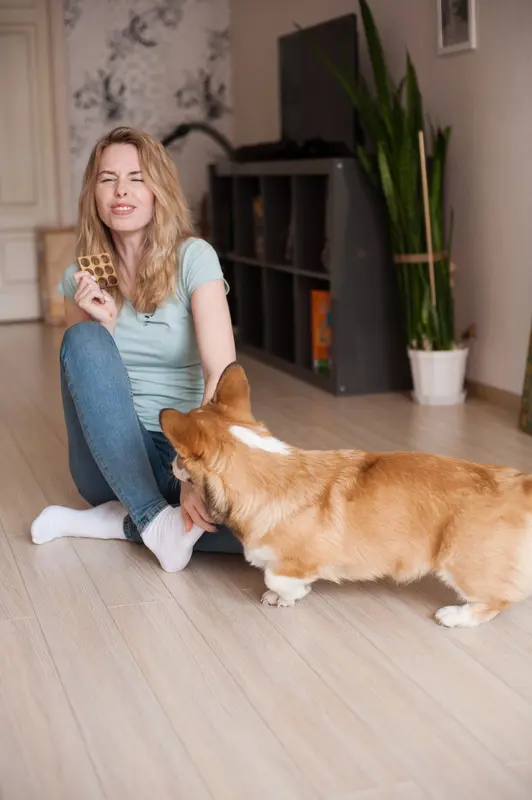
It is a normal instinct for a Corgi to want to nip at ankles occasionally while you are walking. In my experience, this seems more true with younger children, or small animals, as the Corgi tries to “herd them.” While as a puppy, it may be cute, it is crucial to put a stop to it early on unless you want to keep replacing socks due to holes in them or want your children to be afraid of your new puppy.
Herding breeds are typically much more prone to this behavior, which means your Corgi is more than likely to attempt nipping at an ankle here and there. While my Corgi never tried to bite my ankles, he did try with my younger children several times when he was a puppy. Nipping is one of the ways in which they herd sheep and cattle.
While not an option for everyone, what I did with this situation (since my Corgi only ever went after my children’s ankles) was to give a stern “No!,” and then I would pick my child up to “take them away” from our Corgi, thus negating his playtime.
Another option that a few trainers recommend is to redirect them. Keeping a chew toy handy, you can redirect your puppy’s attention by stopping in place, and squeaking the toy loudly until you get your puppy’s focus to change. Then give them the toy to chew on instead once their concentration has moved to it. If you do not have a toy handy, you can also say “no,” “bad,” or try the yelping method, and stop in place. The idea is to get them to stop the bad behavior, and once they do, you can praise them after that. In doing so, you are teaching them that there is a reward for ceasing lousy behavior.
If turning away from and ignoring your dog does not seem to deter them from either of these behaviors, you may have to try to get their attention another way. Clapping your hands together loudly once, immediately followed by “No!” may turn their attention enough to get them to stop doing what they are currently doing. Another startling tool is the Pet Corrector, which can be used the same way as clapping your hands. Otherwise, a quick thump on the bridge of their snout (not hard at all, just enough to get their attention!) may work as well. Follow it up by saying “no” and then turning to ignore them. Ultimately, you’re not trying to hurt your puppy at all. You are merely trying to get their attention to let them know it was not a good thing.
Discipline for Pottying in the House
Potty training, or housebreaking, is another big issue for a lot of new dog owners. Corgis are smart and are capable of quickly learning that pottying in the house is a no-no. The biggest thing to remember when potty training your new pup is that consistency is vital. If you have not been consistent in training your dog that it is not ok to potty in the house, you shouldn’t get on them harshly if they do.
Besides being consistent in taking them out to potty, the next best thing you can do is try to catch them in the act. If you see your Corgi start to squat in the house, immediately say “No!” or “Bad!” or even follow it with a loud clap. The goal is to get their attention, stop them from proceeding, and immediately pick them up and take them outside. Once they go outside, praise them. That way, they understand that you aren’t getting on to them for pottying, but the location they were pottying at.
Standing still and yelling at them will only confuse them. They will understand that you are upset, but they will not understand why. Pushing their face down and rubbing their face in the spot does nothing to help them become housebroken. A dog does not naturally think “inside or outside” when it comes time to potty. Their base instinct is not to potty where they sleep. They will also be more prone to go back and pee in the same area they have previously, especially if they can still smell it from before. Cleaning the area well with a product such as Nature’s Miracle, and then applying citrus-scented sprays to the area can make them not want to visit that spot again. Another thing you can try is to mix isopropyl alcohol and water in equal parts and apply it to the area once a week until they are well housetrained.
Disciplining for Chewing Shoes or Other Objects
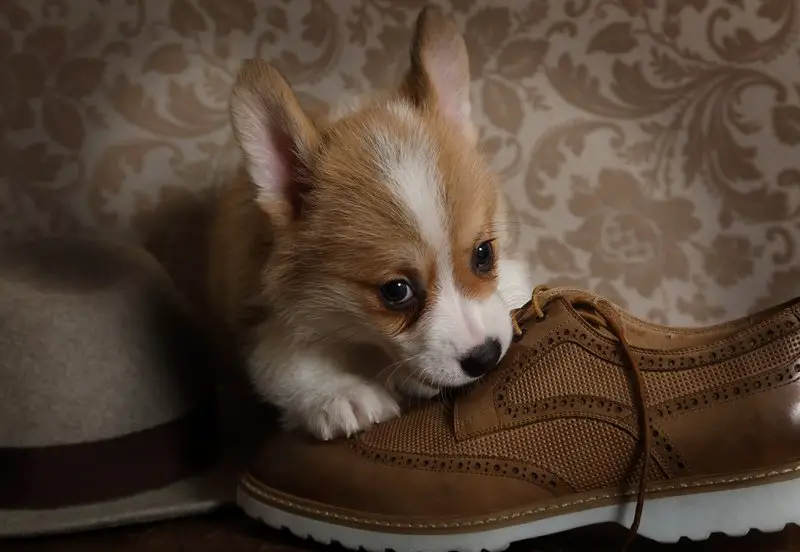
Chewing on shoes, slippers, or other personal items of yours is a normal thing for most puppies to do. They want to explore everything and typically will use their mouths to do so. Also, the smell of your shoes may be comforting or pleasant to them as well. Combine those reasons with the fact they think your shoe makes a great chew toy, and it’s a perfect recipe to lose your favorite pair of sneakers.
Catching your puppy in the act is the easiest way of breaking this habit, but once again, it needs to be consistent. If you catch them in the act, you can always redirect them to something that they ARE allowed to chew on instead. If you are unable to catch them in the act of doing so, other options could include putting your shoes away or high enough off the ground so that they cannot reach them. If they get used to the shoes not being there as a chew toy and have other chew toys available to them, your Corgi puppy should become more accustomed to chewing on them instead.
If that is not a good option for your household, you can try taking away another thing they may like about your shoes. While your wife or kids may find the smell of your sneakers appalling, it doesn’t mean that your puppy will. But, you can make it, so your pup does find the smell appalling. Using a spray on your shoes (or any other item) that your dog finds offensive, he will want to direct his attention elsewhere. Anti-Chew dog training spray is one such item you can get to try out. This particular spray is relatively strong smelling immediately after spraying. You will want to make sure you do not breathe it in. It will make any surface you spray it on incredibly bitter (yes, it is pet-safe though!) and deter your dog from wanting to put their mouths on it. If you want another alternative, most citrus-scented sprays will work in varying degrees. For the most part, dogs do not like the taste or smell of citrus!
How to Properly Discipline a Corgi
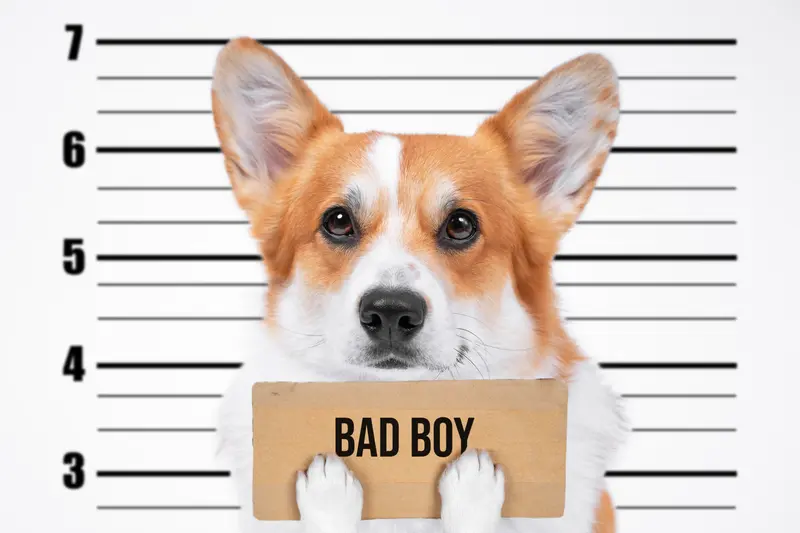
There are a lot of ideas out there on how to “properly discipline” a puppy.
Out of the good methods to use, remember there is no one-size-fits-all. Depending on the situation, and your dog, you will have to determine what works best for discipline and training. Remember that it isn’t always about telling them what they did was wrong, but showing them what behavior you expect of them instead of that incorrect behavior.
With some things, this will be redirecting them consistently until they understand that you don’t want those shoes chewed on, but you are fine with this toy being chewed on instead. Any of the ideas I mentioned above are good to use. One that I do want to reiterate, however, is the tapping their nose. It is imperative that if you do this method, it should only be used seldomly, and only when you are unable to get their attention another way. When you do it, make sure you barely touch their nose, just enough to get their attention. If you “tap” them hard, you will end up making your dog hand-shy and also fearful of you.
In other situations, some people have found that disciplining their puppies as a mother dog would works better for them. If your puppy is about to do something wrong (this needs to be done beforehand, not afterward!), they would loudly growl at the puppy. Doing it enough to get their attention and let them know not to do that is the premise of this method. On the opposite side of that spectrum is making a yelping sound loudly if your puppy bites too hard, much as another pup would. While I have not personally tried the growling or the yelping methods, I know others have had success with it.
How NOT to Discipline a Corgi
Using a Crate as a Punishment
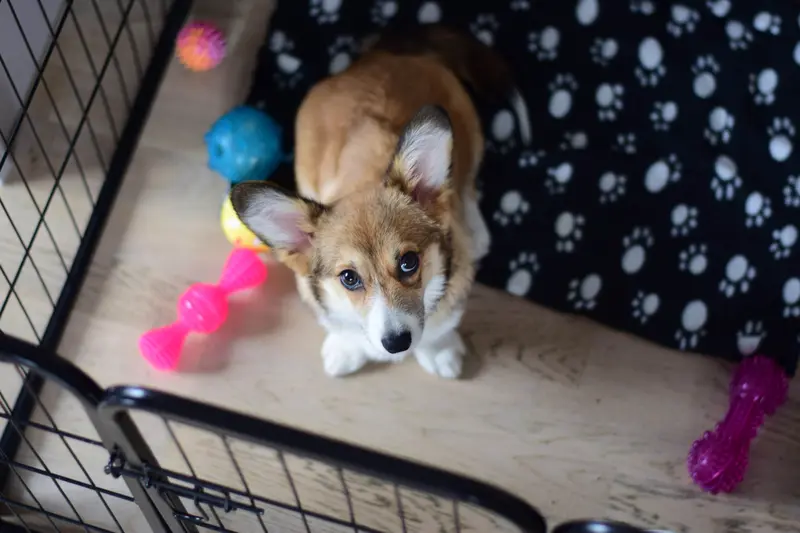
This is one that we see happen quite often. I understand the thought behind putting your dog in a crate for punishment by giving them a time-out. However, your Corgi will more than likely not look at it the same way.
Having your dog crate trained is a good thing. It gives them a place that they feel comfortable and safe. It also helps when you travel, as well as several other reasons. I could go on for a while with why crate training a dog is beneficial for you and the dog, but we’ll leave that for another article.
If you use the crate as a place of punishment, your puppy will learn from an early age that they do not want to be in there. As smart and hard-headed as Corgis can be, you will have to bribe them or force them into their crate when you want them to go in there before long. Then giving them the treat to lure them in there beforehand takes away from the punishment itself. Besides the fact that by the time your dog gets in the crate, he will more than likely not know exactly what it is he is being punished for. If you need to put your puppy in their crate for a time-out for yourself, that is absolutely fine. Just make sure you do so in a manner they don’t feel like they are being punished while in there. If he did something naughty, punish him in one of the proper ways mentioned above. Once he knows what he did was wrong, you can take him out to run in the yard and get himself tired and ready for a nap. Then put him in the crate to sleep while you have your quiet time.
Time Out
As I mentioned above, with crate training, putting a dog in time out is best used as a prevention, and not a punishment. Whether putting them in a crate or a bedroom by themselves, or any other area for time out, they will more than likely not know what they are being punished for.
When used as a preventative instead, and they go in knowing you are happy with them, they will be less likely to associate that area negativity. In doing so, they will be more likely to happily do as you ask and enter their “time-out” area again. If you know that you will be running an errand and think your puppy might be naughty while you are gone, putting them in the crate for a nap would be a good idea. If you are busy working from home and cannot actively watch what your puppy is doing, this is another good time.
Using an Elevated Location
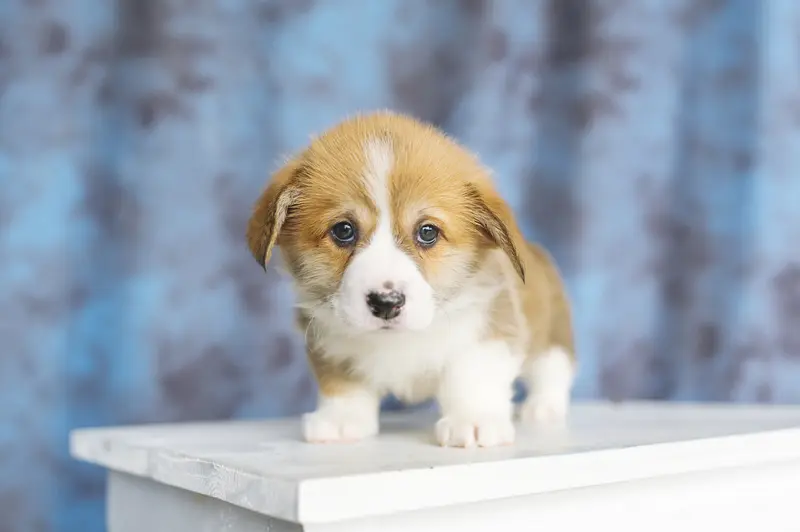
Elevating your dog is a punishment method I have seen a few times with smaller breeds, but thankfully not often. This is a method I highly recommend avoiding. If you do not know what I am referring to, it is when someone would pick up their small dog and put them on a table or somewhere that was high and “too scary for the dog to jump off of.” Doing so makes them feel trapped, and they stay put in place. While I do not think it is a suitable means of punishment for any breed, I believe it is a terrible technique to use with Corgis.
As I have stated several times, Corgis are hard-headed dogs and can be pretty daring if it suits their needs. Letting them be in any situation where they are jumping off objects can cause them to have permanent back issues if they land even slightly wrong. Being a long-backed dog, they are more susceptible to back or spinal issues than many other breeds.
In Conclusion
The most important thing to remember is that when you are disciplining, you should also be teaching! Hitting your dog or being overly physical with them will likely break their trust in you and make training more difficult in the future. Dogs will listen to you much better when they trust you and trust what you are telling them to do.
Try a few of the methods mentioned above, but once you find one that works well and your dog is attentive to, stay consistent! In the long run, you and your Corgi being able to communicate and understand each other’s expectations will lead to training becoming MUCH easier and far more productive.
